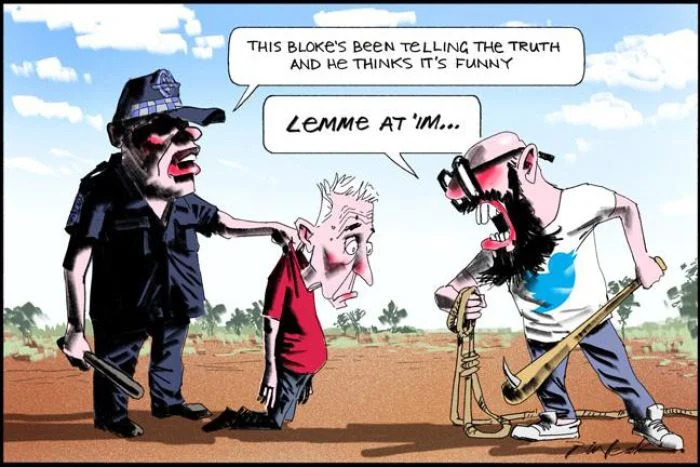Desmond Robert “Bill” Leak was an Australian editorial cartoonist, caricaturist, and portraitist. He was born on 9 January 1956, died on 10 March 2017. Brought up in Condobolin and Beacon Hill, Sydney, Leak attended the Julian Ashton Art School in the 1970s. His cartoons were first published in 1983 in The Bulletin, and after he drew for The Sydney Morning Herald until 1994 when he was recruited by News Limited to contribute to The Daily Telegraph-Mirror and later to The Australian.
 |
|
| Born | |
|---|---|
| January 9, 1956, Adelaide, Australia | |
| Died | |
| March 10, 2017 | |
| Occupation | |
| Editorial Cartoonist, Caricaturist, Portraitist | |
| Notable Works | Editorial cartoons for The Australian, Paintings, Heart Cancer (novel), Face Painting (TV series) |
| Education | Julian Ashton Art School |
| Spouse | Astrid (divorced in the early 1990s) |
| Awards | 9 Walkley Awards, 20 Stanley Awards, News Award (2015, 2016) |
Early life and career beginnings
Desmond Robert Leak was born in Adelaide on 9 January 1956, the second of three children of Doreen and Reg Leak. He was brought up in Condobolin from his birth until 1967 when the family moved to Beacon Hill. He attended Beacon Hill High School and Forest High School, forced to leave the former for the latter after drawing caricatures of his teachers. Remembering what Beacon Hill was like in the early 1970s, Leak described the place as “intellectually barren, culturally hostile and isolated”.
After finishing high school, Leak trained for two years at the Julian Ashton Art School, dropping out before his studies were completed. He also spent time working as a postman. In the late 1970s, Leak departed Australia on an art pilgrimage to Europe. In 1978, he was particularly impressed by an exhibition of the paintings of Paul Cézanne at the Grand Palais in Paris. Whilst in Salzburg that same year, Leak met a woman named Astrid, and they married soon after. The couple lived together in Bavaria until 1982 when they relocated to Australia. They divorced in the early 1990s.
News Limited career
Cartoon
The Leak began drawing cartoons professionally in 1983, first for The Bulletin and then for The Sydney Morning Herald. Leak resigned from The Sydney Morning Herald to take up a role at The Daily Telegraph-Mirror, News Limited newspaper, in 1994. He later moved to The Australian (also News Limited newspaper).
In April 2006, Leak drew a cartoon captioned “No Offence Intended”, depicting an Indonesian person resembling then president, Susilo Bambang Yudhoyono, as a dog mounting a Papuan native. The drawing was in retaliation to a Jakarta Daily cartoon from the previous week, which had depicted the Australian prime minister and foreign minister as dingoes engaged in sexual intercourse, with the prime minister saying “I want Papua!! Alex! Try to make it happen!”. The foreign minister, Alexander Downer, told media that he felt Leak’s cartoon was crude, offensive and potentially racist.

In 2007, a Belgian company that controlled the rights to the cartoon character Tintin, issued Leak a copyright complaint about portraying the then-leader of the opposition, Kevin Rudd, as Tintin (accompanied by Snowy)The complaint was resolved when Leak agreed not to profit from sales of the cartoons.
Editorial Cartoonist
A Leak cartoon published in The Australian in December 2015 depicted starving Indian villagers trying to eat solar panels delivered by the UN, a comment by Leak on the 2015 United Nations Climate Change Conference. The academic Amanda Wise, an associate professor of sociology at Macquarie University, told media that it was her view that the cartoon was racist. Social media commentary, including by Tim Watts, agreed with Wise and condemned the cartoon.
The Australian Press Council dismissed a complaint about the cartoon, saying that “the cartoon is an example of drawing on exaggeration and absurdity to make its point” “by ridiculing [the UN’s] decision to provide solar panels at the expense of more appropriate aid”. The Australian Press Council delivered a ruling on the work in November 2016 that it did not breach standards of practice.

In August 2016, on Aboriginal and Torres Strait Islander Children’s Day, a Leak cartoon in The Australian depicted an Aboriginal policeman holding a teenage male and telling the youth’s father that he needed to teach his son about personal responsibility. The father, with a can of beer in hand, replies “Yeah, right, What’s his name then?”. Muriel Bamblett, head of the Victorian Aboriginal Child Care Agency, as well as Roy Ah-See, chair of the NSW Aboriginal Land Council, and Nigel Scullion, the minister for Indigenous affairs, all labeled the cartoon racist. Western Australian Police Commissioner Karl O’Callaghan and academic Jeremy Sammut defended Leak’s 2016 cartoon, saying it was an appropriate portrayal of some communities and families.

Leak said the cartoon was not racist, reflecting that if the characters he had drawn were white, he would not have been accused of racially stereotyping all white parents as bad parents. A complaint by a woman who said she had been discriminated against as a result of the cartoon triggered an investigation into Leak and The Australian by the Australian Human Rights Commission. The complaint was later withdrawn after the woman behind the complaint was subjected to alleged intimidation and harassment from Leak’s employers at News Limited. The investigation was thus terminated.

Books and TV
In 2005, ABC Books published Leak’s first novel, Heart Cancer. The reviewer Gillian Dooley wrote that the book was not a success, labeling the first half “tedious, crude, self-indulgent and melodramatic” and the end “truly nauseating“.
The leak also released four books of political cartoons:
- Drawing Blood. St Leonards, NSW: Allen & Unwin. 1998. .
- Moments of Truth. Carlton North, Vic: Scribe. 2005.
- UnAustralian of the Year. Brunswick, Vic: Scribe. 2012. .
- Trigger Warning. Melbourne: Wilkinson Publishing. 2017.
Association with the Archibald
In 1984, Leak first entered the Archibald Prize, an annual portraiture competition administered by the Art Gallery of New South Wales. That year, he swore that he would never enter again but changed his mind in 1989, entering a portrait of Don Bradman, which was named as one of 24 finalists that year He entered portraits of Malcolm Turnbull in 1994, Graham Richardson in 1995, Tex Perkins in 1997, Gough Whitlam in 1998, Sir Les Patterson in 2000 and Robert Hughes in 2001.
He won the Packing Room Prize twice (for portraits of Tex Perkins and Sir Les Patterson)and also won the People’s Choice Award for his portrait of Malcolm Turnbull. He was also a subject for People’s Choice Award winners Esther Erlich (2000) and Jo Palaitis (1995).
Awards
Leak won nine Walkley Awards
- 1987 – For best illustration, a picture of then employment and education minister John Dawkins.
- 1989 – For best illustration.
- 1990 – For best illustration.
- 1992 – For best illustration.
- 1993 – For best cartoon.
- 1995 – For best cartoon, “And that’s the Truth.”
- 1996 – For best cartoon, “It’s our ABC.”
- 1997 – For his artwork “The Big Picture.”
- 2002 – For his cartoon “Brown Nose Day.”
Between 1987 and 1998, he was also presented with 20 Stanley Awards – twelve categories (bronze) awards and eight gold for Cartoonist of the Year – and was a two-time winner of ‘News Corps’ News Award for best cartoonist of the year, in 2015 and 2016.
Health
On 18 October 2008, Leak sustained serious head injuries from falling off a balcony while trying to feed African grey parrots and gang-gang. Brain surgery was required, after which he was in serious condition. His partner Lo Mong Lau, along with his elder son Johannes and his mother and sister, joined him to be by his side at the Royal North Shore Hospital, where he was treated. While the outlook was initially poor, he recovered.
Death
On 10 March 2017, Leak died in hospital following a suspected heart attack. He was 61 years old.
See also: Jim Russell (1909 – 2001)
FAQ: Desmond Robert “Bill” Leak (9 January 1956 – 10 March 2017)
1. Who was Desmond Robert “Bill” Leak?
Desmond Robert “Bill” Leak was an Australian editorial cartoonist, caricaturist, and portraitist. He was known for his contributions to the world of art, particularly in political cartoons.
2. Where was Bill Leak raised and educated?
Bill Leak was raised in Condobolin and Beacon Hill, Sydney, Australia. He attended Beacon Hill High School and Forest High School. He also attended the Julian Ashton Art School during the 1970s.
3. When and where were Bill Leak’s cartoons first published?
Bill Leak’s cartoons were first published in 1983 in “The Bulletin.” He later contributed to “The Sydney Morning Herald” until 1994. Afterward, he worked for News Limited, contributing to “The Daily Telegraph-Mirror” and later to “The Australian.”
4. What were some of Bill Leak’s notable achievements as an artist and illustrator?
Bill Leak entered paintings into the Archibald Prize multiple times, winning the People’s Choice Award in 1994 for his portrait of Malcolm Turnbull and the Packing Room Prize twice, in 1997 and 2000, for his portraits of Tex Perkins and Sir Les Patterson, respectively. He was also acclaimed for his talent, passion, and dedication to his craft.
5. Can you provide examples of some of Bill Leak’s controversial cartoons?
Some of Bill Leak’s editorial cartoons that sparked controversy include a 2006 cartoon during the West Papuan refugee dispute, a series of cartoons in 2007 featuring Kevin Rudd as Tintin, a 2015 cartoon depicting starving Indian people attempting to eat solar panels, and two cartoons in 2016, one depicting a neglectful Aboriginal father and another featuring same-sex marriage campaigners wearing rainbow-colored Nazi uniforms.
6. What was Bill Leak’s early life and career journey?
Bill Leak was born in Adelaide on 9 January 1956 and raised in Condobolin and Beacon Hill. He attended art school but dropped out before completing his studies. He spent time working as a postman and embarked on an art pilgrimage to Europe in the late 1970s before returning to Australia and beginning his career as a cartoonist in 1983.
7. How did Bill Leak’s health impact his life?
In 2008, Bill Leak suffered severe head injuries from a fall while attempting to feed African grey parrots and gang-gang cockatoos. He had brain surgery and was seriously ill, but he eventually recovered.
8. When did Bill Leak pass away, and what was the cause of his death?
Bill Leak passed away on 10 March 2017, at 61, following a suspected heart attack.
9. What awards and recognitions did Bill Leak receive during his career?
Bill Leak won nine Walkley Awards and received numerous other accolades, including the Packing Room Prize and the People’s Choice Award at the Archibald Prize.
10. Did Bill Leak create any books or television series?
Yes, Bill Leak authored a novel titled “Heart Cancer,” published in 2005. He also released several books of political cartoons. In addition, he hosted a TV series called “Face Painting,” where he painted portraits of notable individuals, which aired on ABC TV in 2008.
11. What was the controversy surrounding Bill Leak’s cartoon during the same-sex marriage debate?
During a nationwide debate about legalizing same-sex marriage, Bill Leak published a cartoon in The Australian that depicted individuals wearing rainbow-colored Nazi SS uniforms, which generated significant controversy and criticism.
This post was created with our nice and easy submission form. Create your post!




